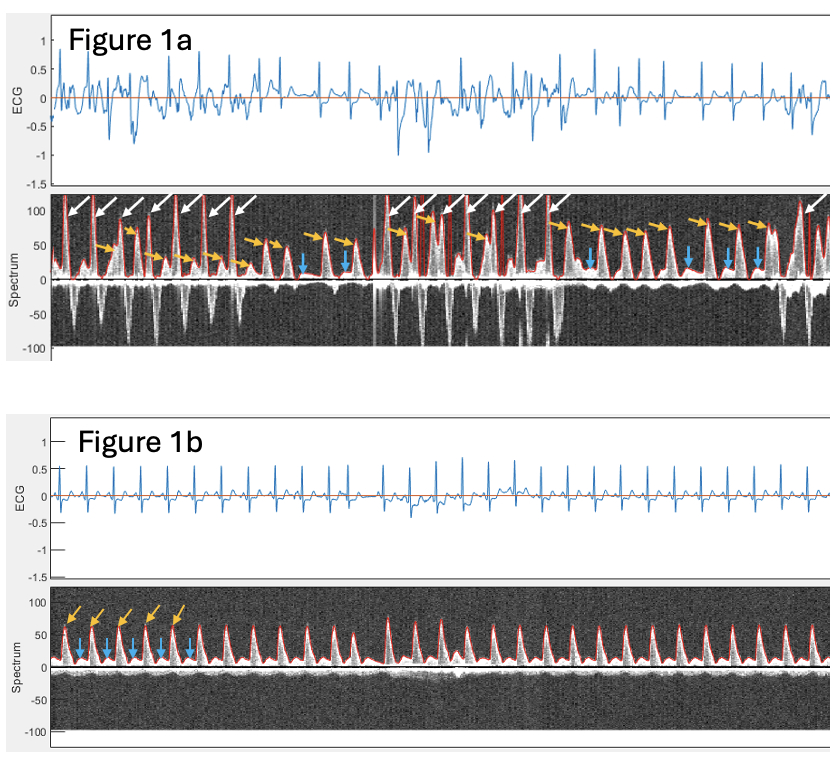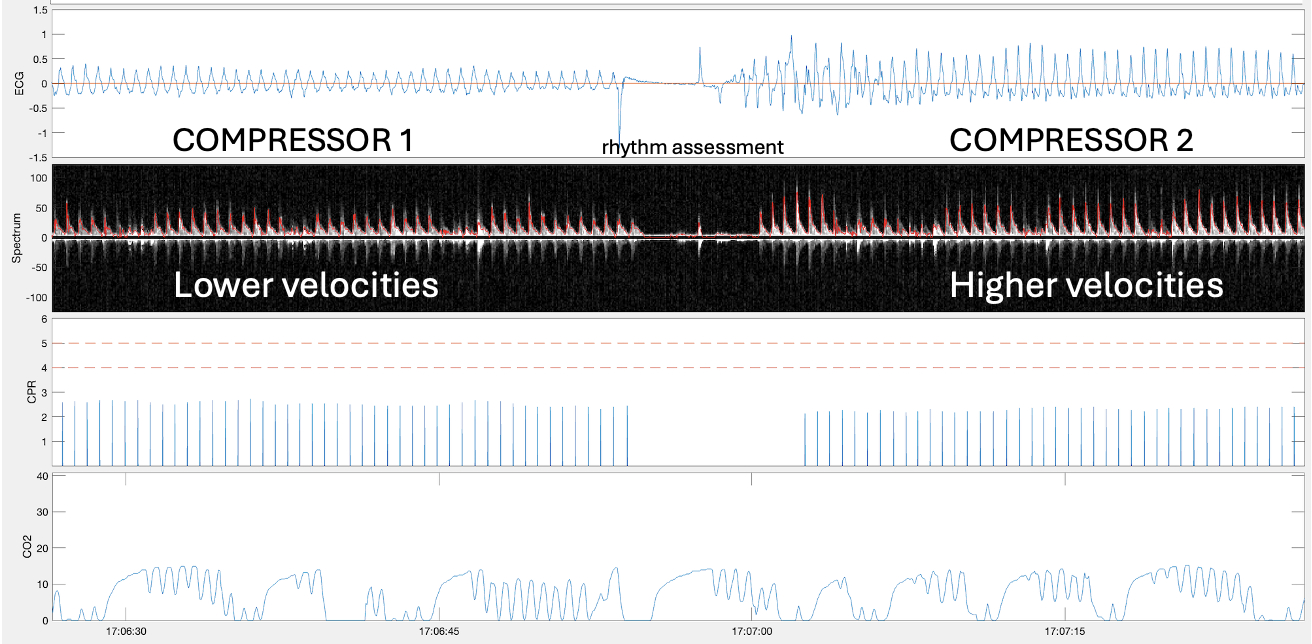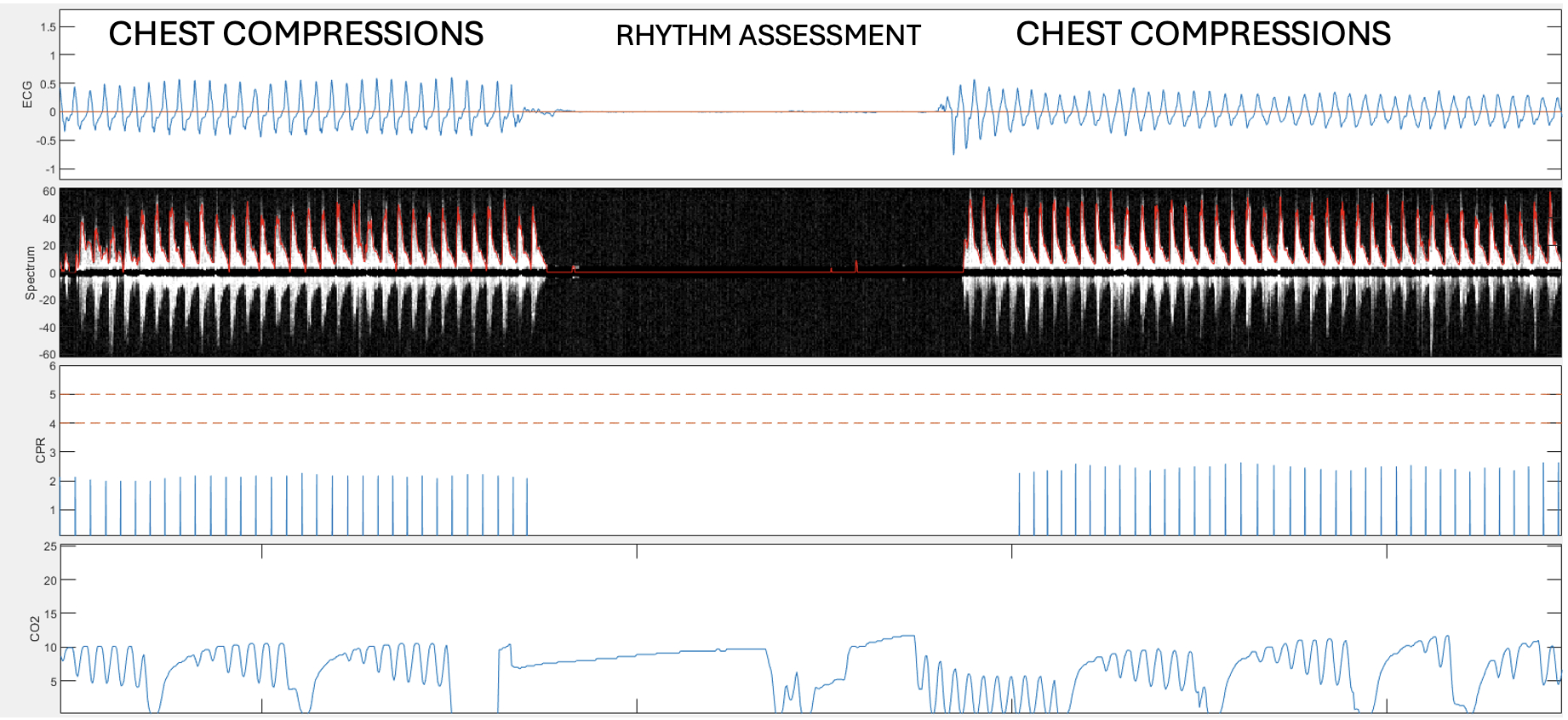Final ID: Sa1404
Realtime Detection of Spontaneous Circulation in Humans During Cardiopulmonary Resuscitation Using a Continuous Hands-Free Carotid Doppler: A Cardiac Arrest Pilot Study
Abstract Body: Background: During cardiopulmonary resuscitation (CPR), ensuring the quality of chest compressions and accurately identifying the return of spontaneous circulation (ROSC) is challenging. There is currently a need for a non-invasive, continous, real-time personalized tool to guide CPR.
Aim: To evaluate in humans whether a novel continuous hands-free carotid Doppler ultrasound system, RescueDoppler (RD), can detect velocities generated by chest compressions and spontaneous circulation during CPR.
Hypothesis: RD can accurately detect spontaneous circulation and monitor the quality of blood flow velocity during compressions in CPR.
Methods: In this pilot study, we included both pre- and in-hospital cardiac arrests to assess the feasibility and clinical utility of RD. The RD probe was positioned over the left common carotid artery using a hydrogel patch by the cardiac arrest team after defibrillator pads were applied. The team was blinded to the real-time ultrasound data for ethical reasons. CPR followed ERC guidelines. Data collected included ECG (Corpuls, Zoll), RD pulse-wave Doppler blood flow velocity curves from the carotid artery, chest compression accelerometer readings, and end-tidal CO2, all synchronized in Matlab. Informed consent was obtained post-cardiac arrest from relatives or the patient.
Results: We included 12 cardiac arrest patients (9 men, mean age 60.6±18.4 years), treated pre-hospital (n=6) and in-hospital (n=6). The RD patch was applied for an average of 35 minutes. Mechanical compression was used in one patient, a chest compression accelerometer in 5 patients and end-tidal CO2 monitoring in 8 patients. Causes of cardiac arrest included hypoxia (n=4), cardiac (n=3), trauma (n=2), stroke (n=1) and hypovolemia (n=2). Initial rhythms were PEA (n=5), asystole (n=4) and ventricular fibrillation (n=3). Eight patients achieved ROSC, with 3 later dying; 7 patients died overall. RD was feasible and successfully detected blood flow velocities. RD identified spontaneous circulation during CPR and rhythm checks (Figure 1a), ROSC (Figure 1b), chest compression-generated peak velocities (Figure 2), and absence of flow during asystole (Figure 3).
Conclusions: Hands-free continuous carotid blood flow monitoring is feasible during CPR and cardiac arrest in humans. RescueDoppler successfully detected spontaneous circulation and chest compression-generated blood flow, offering potential for real-time personalized CPR that could improve outcomes and save lives.
Aim: To evaluate in humans whether a novel continuous hands-free carotid Doppler ultrasound system, RescueDoppler (RD), can detect velocities generated by chest compressions and spontaneous circulation during CPR.
Hypothesis: RD can accurately detect spontaneous circulation and monitor the quality of blood flow velocity during compressions in CPR.
Methods: In this pilot study, we included both pre- and in-hospital cardiac arrests to assess the feasibility and clinical utility of RD. The RD probe was positioned over the left common carotid artery using a hydrogel patch by the cardiac arrest team after defibrillator pads were applied. The team was blinded to the real-time ultrasound data for ethical reasons. CPR followed ERC guidelines. Data collected included ECG (Corpuls, Zoll), RD pulse-wave Doppler blood flow velocity curves from the carotid artery, chest compression accelerometer readings, and end-tidal CO2, all synchronized in Matlab. Informed consent was obtained post-cardiac arrest from relatives or the patient.
Results: We included 12 cardiac arrest patients (9 men, mean age 60.6±18.4 years), treated pre-hospital (n=6) and in-hospital (n=6). The RD patch was applied for an average of 35 minutes. Mechanical compression was used in one patient, a chest compression accelerometer in 5 patients and end-tidal CO2 monitoring in 8 patients. Causes of cardiac arrest included hypoxia (n=4), cardiac (n=3), trauma (n=2), stroke (n=1) and hypovolemia (n=2). Initial rhythms were PEA (n=5), asystole (n=4) and ventricular fibrillation (n=3). Eight patients achieved ROSC, with 3 later dying; 7 patients died overall. RD was feasible and successfully detected blood flow velocities. RD identified spontaneous circulation during CPR and rhythm checks (Figure 1a), ROSC (Figure 1b), chest compression-generated peak velocities (Figure 2), and absence of flow during asystole (Figure 3).
Conclusions: Hands-free continuous carotid blood flow monitoring is feasible during CPR and cardiac arrest in humans. RescueDoppler successfully detected spontaneous circulation and chest compression-generated blood flow, offering potential for real-time personalized CPR that could improve outcomes and save lives.
More abstracts on this topic:
A Rare Case of Adalimumab-Induced Cardiac Tamponade in a Patient with Psoriatic Arthritis
Raval Akhinav, Tran Minh, Saini Ishveen, Rea Mark
A Novel Method to Assess the Brain Functional Condition through Visualization of its Emitted Infrared Waves.Ghevondyan Tigran



